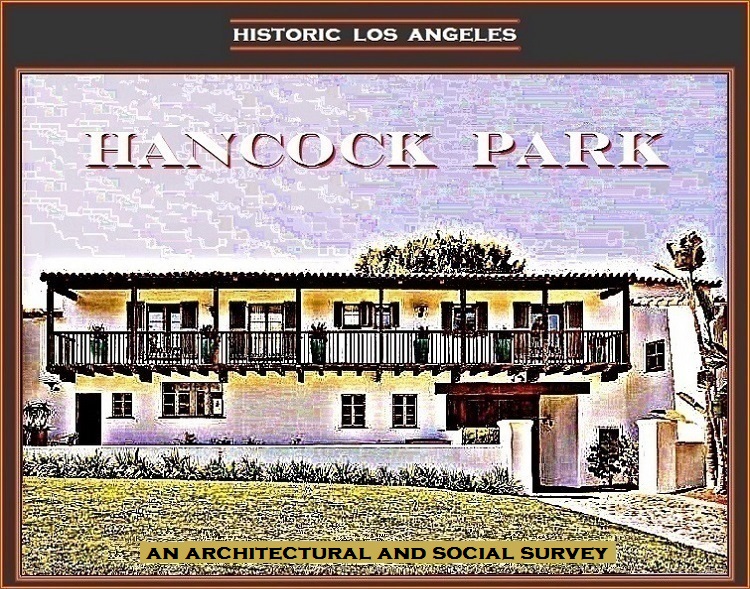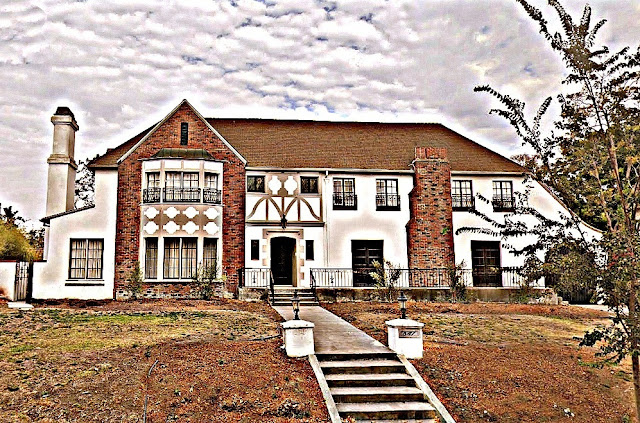PLEASE SEE OUR COMPANION HISTORIES
AN INTRODUCTION TO HANCOCK PARK IS HERE
647 South June Street
- Built in 1926 on Lot 17 in Tract 6388
- Original commissioner: real estate developer Harold Vorce as a speculative project
- Architect and contractor: George Olerich
- On March 19, 1926, the Department of Building and Safety issued Harold Vorce permits for a two-story, 12-room residence and a one-story, 20-by-30-foot garage at 647 South June Street
- The house began to be offered for sale in the Times by mid-August 1926: "JUST COMPLETED—647 S. JUNE: One of the most complete English homes ever offered for sale in Hancock Park. Construction and location par-excellent. We are not describing the house for the location is enough. See this today. Do not wait." Even with the 1920s still roaring, Los Angeles developers tended to get over their skis in terms of their profit dreams and promotion of Hancock Park as the be all and end all; buyers waited, and their were plenty of other English-style houses to be had in Hancock Park, not to mention in still-attractive high-end neighborhoods that were scarcely 20 years old. And, too, there was stiff competition from new developments in Beverly Hills, and west, where Bel-Air, for example, tended to put Hancock Park in the middle-class shade. Two years after construction began, 647 South June would be auctioned off
- Born in Yonkers, New York, on November 16, 1870, Joseph Dubois Simpson arrived in Los Angeles in 1890 and began as a salesman dealing in wholesale fruit, joining his older brother Frank, already established locally in the wholesale fruit trade. The Simpson brothers would have various partners over the years and became leading produce dealers in Los Angeles. In 1909 Joseph Simpson led the development of the Los Angeles City Market at Ninth and San Julian streets while other produce men opened a produce distribution facility at Sixth and Alameda. The resulting turf war and its resolution was described in the Record on August 25, 1911: "A bitter fight that has been waged for the past two years between the largest dealers in the local produce market came to an amicable settlement...when negotiations were finally completed whereby the interests of the Frank Simpson Fruit Co. were purchased by the Los Angeles Public Market Co. and the Kline [sic] Fruit Co." Frank Simpson appears to have retired, with his brother remaining with the merged operations. The Klein-Simpson Fruit Company would prosper and grow and, soon after Joseph's move to Hancock Park, be combined with two other other local wholesale fruit dealers to form the Consolidated Produce Company. Before acquiring 647 South June Street, the Joseph Simpsons lived with his wife's father and her brother Ernest in a house the family had built in 1899 at 725 South Union Avenue. In 1922, they'd moved to 665 Wilshire Place, across the street from his brother Frank at 670
- Joseph Simpson married 22-year-old Newark, New Jersey, native Alice Emily Stent in Los Angeles on July 30, 1891; she was a daughter of English-born architect Thomas Stent, who'd practiced in Canada, New York City, and later in Los Angeles (among work credited to him was San Francisco's city hall of 1898-1906). The Simpsons had three children. Dorothy was born in March 1892, Donald in March 1894, and Ernest in May 1901, the sons eventually following their father into fruit; by the time their parents moved to their 12-room house in Hancock Park, Dorothy and Donald were long married, Ernest having married in November 1926
- The purchase of 647 South June may have been a celebratory gesture to Joseph Simpson's success and the expected merger of his company, a long-envisioned retirement home, but it was also a necessity, the Simpsons having sold 665 Wilshire Place to John G. Bullock, who was planning the construction of his towering Bullock's-Wilshire store, which would open in September 1929 covering the footprint of 665 (as well as of 655 Wilshire Place and other residences). Though today the southerly blocks of Hancock Park, including that of 647 South June, have been encroached upon by large buildings, the subdivision was in 1929 safely away from the rapid commercialization of easterly Wilshire Boulevard and that to the west along the Miracle Mile. Interestingly, Frank Simpson, who was 15 years older than Joseph, chose to stay in his house on the east side of Wilshire Place, deep in the afternoon shadow of Bullock's-Wilshire, until his death at 98 in 1954
- On June 22, 1928, Joseph Simpson was issued a permit to build a roof over an unspecified porch at 647 South June Street
- Curiously, the 1930 Federal census enumerates spiritualist minister James B. Shaw as a "roomer" at 647 South June Street; ads in the press has him associated with various religious entities including the Divine Science Church
- Joseph and Alice Simpson appear to have lived quietly at 647 South June Street until her death on May 12, 1949. Joseph remained in the house until he died there on November 8, 1953. His obituaries noted his burgher status, citing his founding of the Ninth Street produce market and his presidencies of the Los Angeles Board of Trade and of the Los Angeles Credit Men's Association; he had also served as a director of the Merchants and Manufacturers Association
- The Simpson family retained 647 South June Street for a year or so after the death of Joseph, renting it for period to Dr. Margaret G. Markwell, whose title may have been presumed by her and not one granted by an institution. In the 1940 Federal census she was enumerated as a "reducing garment saleswoman" in a corset factory; by 1950 she was the "nurse manager" of a nursing home. She was also an opera buff who held a number of meetings of her opera clubs at 647 during her tenancy
- 647 South June Street was being offered for sale by November 1954; it would be acquired by Bible teacher Otis Quinten Sellers, director of The Word of Truth Ministry, which he founded in 1936. According to its website, the organization's sole purpose [is] "the presentation of well-studied Biblical information." It rather ironically endeavors "to help/encourage anyone interested in knowing more about what the Bible truly contains, as contrasted with what some would have us believe it contains." Sellers described himself in his own literature as "a Christian individualist...not 'fronting' for any denomination, group, sect, or cult." He claimed to be "no part of the religious monstrosity that travels under the canopy called 'the church'...." (More on Sellers's modesty here)
- Though given more to describing the world as being on the verge of apocalypse, Otis Sellers is reminiscent of Dr. James Fifield, infamously a supporter of Senator Joseph McCarthy and minister of Los Angeles's First Congregational Church—presumably part of "the religious monstrosity"—who nevertheless also believed in housing himself splendidly while preaching of Christ's humility. (Fifield lived at 118 Fremont Place, among other less-than-humble dwellings.) At any rate, Sellers may have overextended himself with the upkeep of 647 South June. The house was on the market by late summer 1962 and by that fall being offered at a "drastic price reduction." It lingered for sale at least into the summer of the next year
- Real estate developer Leslie Sugar was the owner of 647 South June Street by late 1963. Sugar proceeded to demolish the property's original garage and replace it with a 10-by-20-foot carport, permits for which were issued by the Department of Building and Safety on February 6, 1964. A permit issued to Sugar on October 9, 1964, called for the addition of a one-story, 20-by-33-foot addition to the rear of the residence. On October 29, a permit was issued for an 12-foot-high concrete block and chain-link fence at the rear of the lot presumably to help block the noise of the recreation yards of the John Burroughs Middle School to which 647 backs up. A diagram appearing on a permit issued on December 17 indicates that Sugar had in mind to create a south-side driveway, presumably allowing for vehicles to circle through the north-side porte-cochère and around the house; on February 18, 1965, a permit was issued to Sugar for a new one-story, 27-by-20-foot garage on the south side of the property, a certificate of occupancy for which was issued a year later. The south-side driveway appears to have since been decommissioned, the 1965 garage converted into a guest house–cabana. A tennis court, its installation date unclear but perhaps built at the time of that possible change, is at the rear of the property
- 647 South June Street was on the market in the summer of 1982. It was featured without an image in the Times on August 21; the asking price was $1,150,000 and its north-south tennis court—the date of its addition unclear—was noted. "The home features a two-story entry with a marble floor and a stained-glass skylight. The living room and walnut-paneled den have teak-herringbone parquet flooring. Staff quarters and a deck with sauna are also offered."
- Attorney Michael H. Diamond, Los Angeles managing partner of the New York firm Skadden, Arps, Slate, Meagher & Flom, was the owner of 647 South June by the spring of 1985. Per permits issued by the Department of Building and Safety in 1985 and 1986, Diamond proceeded to remodel the kitchen and at least one bath and to add three fireplaces, one with a tall plastered chimney on the south side of the house. Also built was an 8-by-25-foot space over the 1964 rear addition. Diamond also added a 15-by-40-foot swimming pool to the property and built the property's third garage, a 20-by-20-foot building at the end of the original north-side driveway, replacing the 1964 carport. (As noted, the 1965 garage was at some point converted into a guest house–cabana.) Diamond and his wife Marilyn were still living at 647 South June Street into the 2000s. A permit issued to Mrs. Diamond in March 1994 called for chimney repairs after the Northridge earthquake; this may account for the unattractively truncated front chimney, which contrasts curiously with the tall almost freestanding chimney at the south side of the residence
- 647 South June Street was on the market in January 2016 asking $4,500,000. It sat unsold for most of the year, its price seemingly against logic rising to $6,350,000 by December. (The logic is actually sound, with many people believing that the more they have to pay for something, the more desirable it is.) In 2023 the house appears to be on its second owner since 2018




